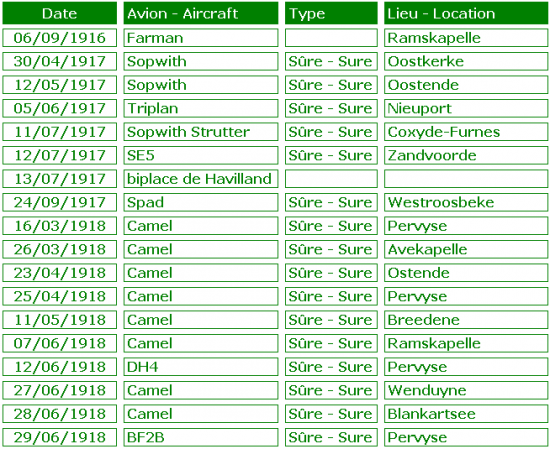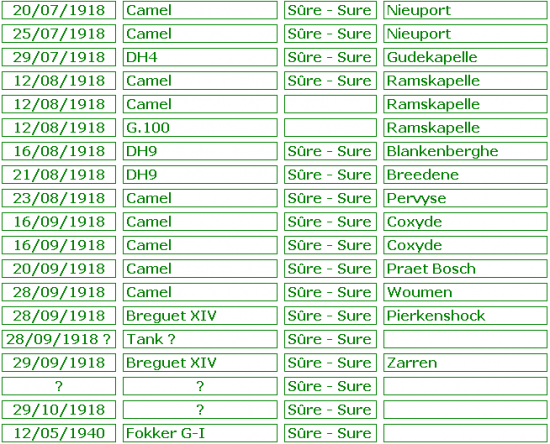Theo Osterkamp
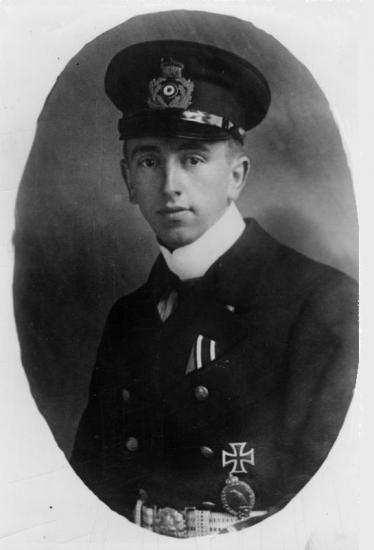
Theo Osterkamp, 1918 © Bundesarchiv Bild 183-R22853
(Cette image est soumise aux droits de Creative Commons Attribution ShareAlike 3.0 Germany License)
(This picture is licensed under Creative Commons Attribution ShareAlike 3.0 Germany License)
Theodor Osterkamp est né le 15 avril 1892 à Aschersleben, en Saxe-Anhalt. Garde forestier, il veut s’engager en 1914 mais trop chétif, il est refusé. Il s’entête et harcèle les bureaux de recrutement de Berlin et finit par être enrôlé le 27 août 1914 dans le Freiwilliges Maarinefliegerkorps (corps des volontaires de l’aéronavale). Il est envoyé à Johannisthal. Il effectue son premier vol en place avant d’un biplan Taube (pilote Gutschmidt à l’arrière) vers la fin de l’année : ce vol fut mouvementé et les deux hommes légèrement blessés à l’atterrissage.
Theodor Osterkamp was born on April 15th, 1892 at Aschersleben, in Saxony-Anhalt. Forest warden, he wants to engage in 1914 but too sick, he is refused. He persists and harasses the recruitment offices in Berlin and finally is enlisted on August 27th, 1914 in Freiwilliges Marinefliegerkorps (corps of volunteers of the Fleet Air Arm). He is sent to Johannisthal. He makes his first flight in front position on a biplane Taube (pilot Gutschmidt on the rear seat) at the end of the year : this flight was rather hard and both men were slightly injured when landing.
La première guerre mondiale - WWI
En février 1915, il intègre le Marine-Landflieger-Abteilung. A la fin du mois, il effectue comme observateur un vol avec le pilote Wilhelm Mattheus sur un Rumpler B.I. Mattheus décide de se poser à Steinau pour saluer son frère, officier dans l’armée du Kaiser. A l’atterissage, un peu brutal, la roue se casse. Ils répareront sommairement cette roue et repartent pour l’aérodrome de Breslau-Gandau où, à court de carburant, ils se poseront au milieu d’une parade militaire, semant la panique parmi les cavaliers. La roue cassera de nouveau et l’avion finira dans un bois de sapins, les deux hommes étant secoués mais saufs.
In February, 1915, he integrates the Marine-Landflieger-Abteilung. At the end of the month, he makes a flight as an observer with the pilot Wilhelm Mattheus on a Rumpler B.I. Mattheus decided to land in Steinau to visit his brother, officer in the Kaiser's army. Landing a bit roughly, the wheel broke. They repaired it rapidly and left for the airfield of Breslau-Gandau where, short of petrol, they landed in the middle of a military parade, spreading panic among the horseriders. The wheel broke again and the plane finished in a pine tress forest, both men being shocked but safe.
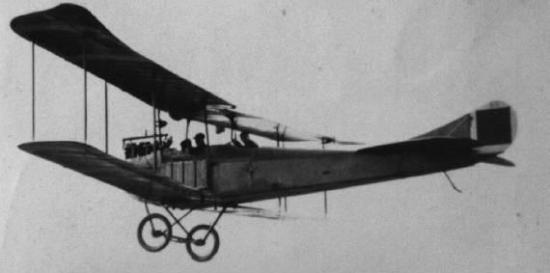
Rumpler B.I. - Photo : source inconnue - Source unknown
Le 24 mars 1915, les deux hommes partent à Wilhelmshaven pour apprendre les règles de l’aéronavale. Trois plus tard, Osterkamp est muté au II. Marine-Landflieger-Abteilung à Moorsele : l’unité est équipée de biplans Albatros B.I. Cet avion, dédié à l’observation n’avait pas d’armes de défense ; Osterkamp s’en plaindra et demandera des mitrailleuses. Il ne sera pas entendu tout de suite. En attendant, il se défend avec un fusil Mauser semi-automatique. Le 7 septembre 1915, Theo est promu Vizefeuerwerker et reçoit la Croix de Fer de 2° classe. Il sera reconnu comme un observateur excellent : il repèrera par exemple le QG de la 4e armée lors d’une mission au dessus de Dunkerque et Boulogne.
On March 24th, 1915, both men left to Wilhelmshaven to learn the rules of the Fleet Air Arm. Three months later, Osterkamp is sent to the II. Marine-Landflieger-Abteilung at Moorsele : the unit is equipped with biplanes Albatros B.I. These planes, dedicated to observation had no defense weapons ; Osterkamp complained about this and asked for machine guns. He was not immediately heard. In the meantime, he assured the plane defense with a semi-automatic Mauser rifle. On September 7th, 1915, Theo was promoted Vizefeuerwerker and received the Iron Cross 2nd class. He was knwon as being an excellent observer : he found for example the HQ of 4th army during a mission above Dunkirk and Boulogne.
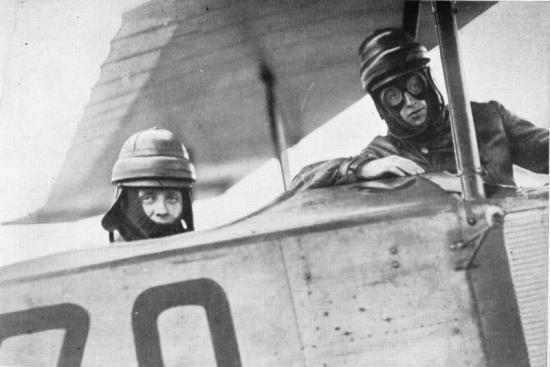
Wilhelm Mattheus & Theo Osterkamp Photo : source inconnue - Source unknown
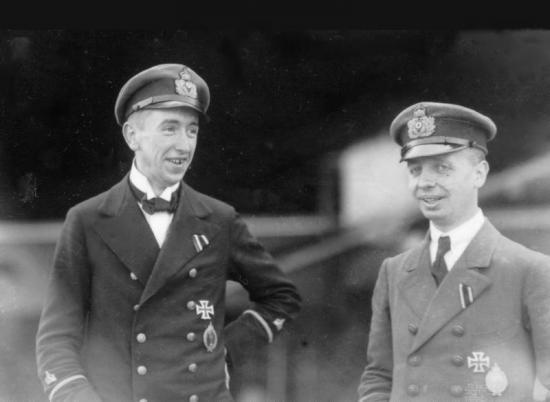
Theo Osterkamp & Wilhelm Mattheus © Thorsten Pietsch http://frontflieger.de
Le 26 mai 1916, Osterkamp et Mattheus reçoivent la mission de bombarder « à la main » le Monitor, navire de guerre de la Royal Navy. Osterkamp dispose de 4 bombes de 10 kg. La première déclenche une forte explosion sur le pont arrière du navire. Puis ils prennent le cap retour, le Monitor leur tirant dessus.
On May 26th, 1916, Osterkamp and Mattheus received the mission to bomb " by hand " the Monitor, a warship of the Royal Navy. Osterkamp had 4 bombs of 10 kg each. The first one activated a strong explosion on the rear part of the ship. Then they flew back, being shooted by the Monitor.
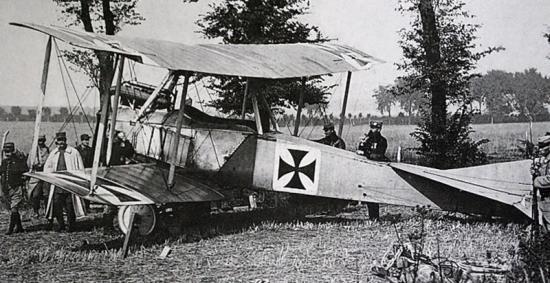
LVG C.II - Photo : domaine public - Public domain
Le 6 septembre 1916, Osterkamp et Mattheus décollent à bord d’un LVG C.II LF 143 B pour une mission photographique sur Ramscappelle. Voulant porter secours à un autre appareil attaqué par un Farman, Osterkamp tire à la mitrailleuse sur un second Farman aperçu au dernier moment et l’abat. Ce sera sa première victoire, bien qu’elle ne fût pas reconnue. Mais il reçoit la Croix de Fer de 1ère classe le 24 septembre 1916. En mars 1917, Osterkamp suit les cours de la chasse à Johannisthal pour devenir pilote : il obtient ses brevets en 8 jours.
On September 6th, 1916, Osterkamp and Mattheus took off aboard a LVG C.II LF 143 B for a photographic mission on Ramscappelle. When helping another aircraft attacked by a Farman, Osterkamp fired with the machine guns a second Farman discovered at the last minute and shot it down. It was his first victory, although it was not homologated. But he received the Iron Cross 1st class on September 24th, 1916. In March, 1917, Osterkamp attended the fighting class at Johannisthal to become a pilot : he obtained his licence within 8 days.
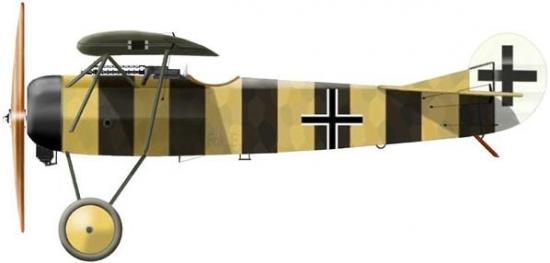
Fokker E.V. - Theo Osterkamp
Jabbeke, Belgique, septrembre 1918 - Jabbeke, Belgium, September 1918.
© Ronny Bar
Il essaye des Fokker E.II, E.IV puis D.II à la Fokker Schule de Putzig. Le 13 avril 1917, il est affecté à la 1ère escadrille de chasse de la marine (I. Marine-Feld-Jagdstaffel) en Belgique à Aartrijke sur Albatros. Le 30 avril, il casse le train d’un Albatros D.III à l’atterrissage et sera suspendu deux semaines. Il décollera cependant pendant cette suspension et abattra un Sopwith près de Dixmude, sa première victoire officielle.
He flew Fokker E.II, E.IV and then D.II at the Fokker Schule from Putzig. On April 13th, 1917, he is sent to the 1st navy fighter squadron (I. Marine-Feld-Jagdstaffel) in Belgium at Aartrijke on Albatros. On April 30th, he broke the landing gear of an Albatros D.III when landing and was suspended two weeks. He passed over this suspension and shot down a Sopwith near Dixmude, his first official victory.
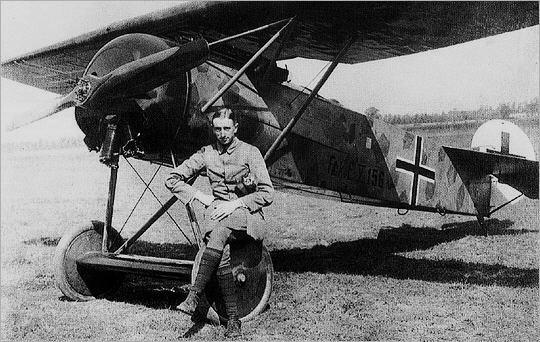 Theo Osterkamp & Fokker E.V. - Photo : source inconnue - Source unknown
Theo Osterkamp & Fokker E.V. - Photo : source inconnue - Source unknown
Le 12 mai, il abat un appareil Belge. Le 5 juin, il obtient sa 3ème victoire sur un triplan Sopwith. Le 6 juin, Mattheus le rejoint. L’unité est rééquippée en Albatros DV. Theo Osterkamp fait peindre une croix de Malte et deux bandes noires sur son D.V D.2130/17 qui ressemble ainsi à une guêpe. Osterkamp, devenu Leutnant, abat sur cet avion un Sopwith le 11 juillet et un SE 5 du 56 Sqn le 12 : il devient ainsi un as avec 5 victoires. Le lendemain, son avion fut sérieusement touché par un De Havilland et Osterkamp atterrit difficilement pour finir dans des barbelés.
On May 12th, he shot down a Belgian aircraft. On June 5th, he claimed his 3rd victory on a triplan Sopwith. On June 6th, Mattheus joined him. The unit is re-equiped with Albatros DV. Theo Osterkamp painted a Maltese cross and two black strips on his D.V D.2130/17 which then looked like a wasp. Osterkamp, who became Leutnant, shot down with this plane a Sopwith on July 11th and a SE 5 of 56 Sqn on the 12th : he then became an ace with 5 victories. The next day, his aircraft was seriously damaged by a De Havilland and Osterkamp landed with difficulties and finished in barbed wires.
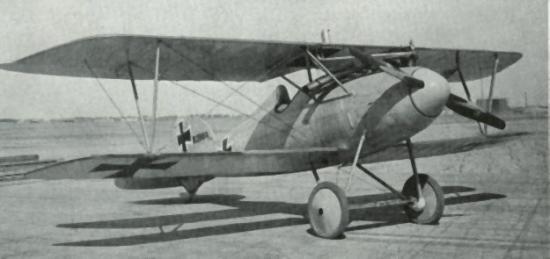
Albatros D V - Photo : domaine public - Public domain
Respectueux de ses adversaires, Osterkamp affronta William Bishop dans un combat qui finit en match nul. Il fut également abattu par George Guynemer le 27 juillet 1917 qui le survola et le salua après son crash (cette victoire ne fut pas reconnue à Guynemer faute de témoin). Le 10 août 1917, Osterkamp reçoit la Croix de Chevalier avec épées de l’Ordre de la Maison des Hohenzollern. Le 10 septembre 1917, la I. Marine-Feld-Jagdstaffel est mutée à Koolkerke. Osterkamp obtient fin septembre une 6° victoire en forçant le capitaine Guy d’Aymery à poser son Spad VII n° 2119 dans les lignes allemandes. Le 15 octobre, Osterkamp est muté à la II. Marine-Feld-Jagdstaffel basée à Snellegem, près de Bruges. Le 22, il va avec Gotthard Sachsenberg essayer le monoplan Junkers J 7. Malgré leur avis favorable, l’Inspection du Matériel Volant (l’Idflieg) ne le retiendra pas.
Respectful of his ennemies, Osterkamp faced William Bishop in a fight which ended in draw. He was also shot down by George Guynemer on July 27th, 1917 who greeted him after he crashed (this victory was not attributed to Guynemer by the lack of witness). On August 10th, 1917, Osterkamp received the Knight's Cross with Swords of the Order of Hohenzollern's House. On September 10th, 1917, the I. Marine-Feld-Jagdstaffel was moved to Koolkerke. Osterkamp obtained in late September a 6th victory by forcing captain Guy d'Aymery to land his Spad VII n° 2119 in the German lines. On October 15th, Osterkamp was sent to the II. Marine-Feld-Jagdstaffel based at Snellegem, near Bruges. On the 22nd, he went with Gotthard Sachsenberg and tried the monoplane Junkers J 7. Despite their favorable opinion, the Inspection of the Flying Equipment (the Idflieg) did not retain it.
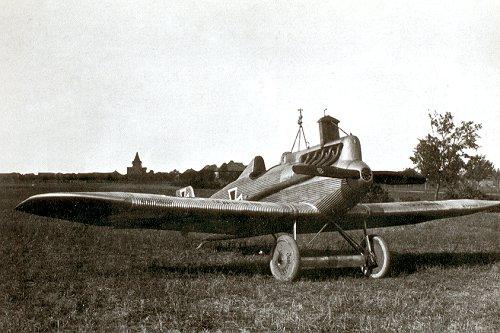
Junkers J7 - Photo : source inconnue - Source unknown
Son ami Mattheus grièvement blessé le 28 décembre 1917 décèdera le 16 janvier 1918 : Osterkamp s’en remettra difficilement. Il ne renouera avec le succès que le 26 mars 1918 en abattant un Camel. Puis deux autres Camel les 26 mars ( ?) et le 23 avril et enfin sa 10ème victoire le 25 avril sur une Spad. Il abattra aussi par erreur un Rumpler C.VII qui atterrira en catastrophe à Wenduyne. Le 27 avril, Osterkamp reçoit les Croix Frédéric Auguste d’Oldenburg 1ère et 2ème classes. Le 1er juin, il est nommé Chevalier de l’Ordre d’Albert. Le 11 mai, il abat un Camel (B7192) du 213 Sqn. Puis 5 autres victoires en juin à bord d’un Fokker D VII. Son score est à 16 victoires.
His friend Mattheus seriously injured on December 28th, 1917 died on January 16th, 1918 : Osterkamp hardly recovered from it. He had success again only on March 26th, 1918 by shooting down a Camel. Then two other Camels on March 26th (?) and April 23rd and finally his 10th victory on April 25th on a Spad. He shot down by mistake a Rumpler C.VII which hardly landed at Wenduyne. On April 27th, Osterkamp received Crosses Frédéric Auguste d'Oldenburg 1st and 2nd classes. On June 1st, he was named Knight of the Albert Order. On May 11th, he shot down a Camel (B7192) of 213 Sqn. Then 5 other victories in June aboard a Fokker D VII. His score was then 16 victories.
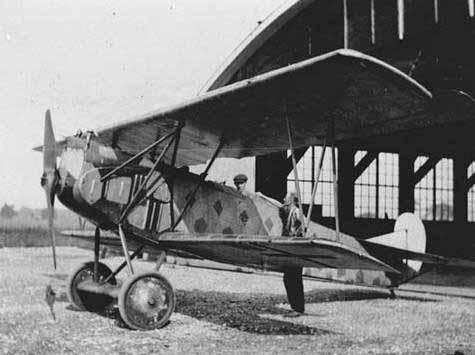
Fokker D VII - Photo : domaine public - Public domain
Le 12 août 1918, Théo obtient sa 20e victoire (un Sopwith Camel D9507 du 17 Aero Sqn) lors d’une sortie de groupe menée par Sachsenberg qui lui, obtient sa 21e. Pourtant ce jour là, Osterkamp aurait abattu un autre Camel et un G 100 mais qui ne lui seront pas accordés. En août, le Leutnant zur See Osterkamp obtient 4 nouvelles victoires soit un total de 23 victoires. Il sera abattu en essayant un Fokker E.V. par trois Spad et sautera en parachute (vraisemblablement début septembre). Le 2 septembre 1918, il reçoit la Croix pour le Mérite. Le 16, il abat 2 Camel du 210 Sqn (B7271 et D3357) et devient ainsi le premier as des pilotes de la marine. Du 17 septembre au 11 novembre, il abattra 7 avions dont un doublé le 28 septembre (un Camel du 204 Sqn et un Bréguet XIV A2 de la 2e escadrille belge). Il abattra aussi un … char qu’il comptera comme sa 29e victoire ! Bien que l’on ne retrouve pas de trace de ses 3 dernières victoires obtenues en octobre 1918, il terminera la guerre avec 32 victoires sûres plus 6 probables.
On August 12th, 1918, Théo obtained his 20th victory (a Sopwith Camel D9507 of 17 Aero Sqn) during a mission of a group led by Sachsenberg who obtained his 21st victory. However this day, Osterkamp would have shot down another Camel and a G 100 but it was not granted to him. In August, the Leutnant zur See Osterkamp obtained 4 new victories for a total of 23 victories. He was shot down when testing a Fokker E.V by three Spad and jumped in parachute (probably early September). On September 2nd, 1918, he received the War Merit Cross. On the 16th, he shot down 2 Camels of 210 Sqn (B7271 and D3357) and then became the first ace among the pilots of the navy. From September 17th till November 11th, he shot down 7 planes including a double victory on September 28th (a Camel of 204 Sqn and a Bréguet XIV A2 of the 2nd Belgian Squadron). He also shot down a tank which he claimed as his 29th victory ! Although we do not find any track of his last 3 victories obtained in October, 1918, he ended the war with 32 victories plus 6 probable.
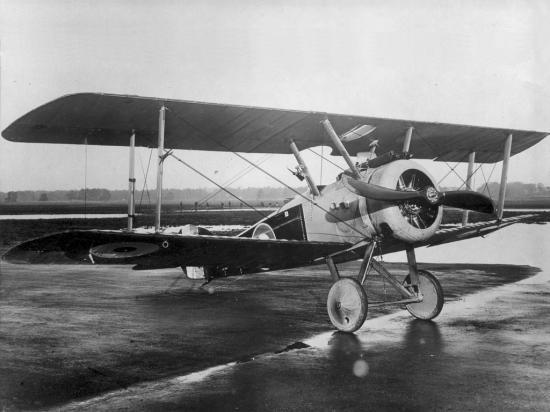
Sopwith Camel - Photo : domaine public - Public domain (UK Government)
L'entre deux guerres - Between the wars
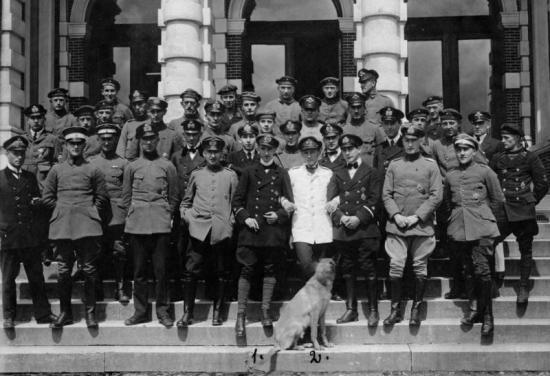
Theo Osterkamp (1) & Gotthard Sachsenberg (2), 1918 © Bundesarchiv Bild 183-2008-1016-509
(Cette image est soumise aux droits de Creative Commons Attribution ShareAlike 3.0 Germany License)
(This picture is licensed under Creative Commons Attribution ShareAlike 3.0 Germany License)
Après l’armistice, Gotthard Sachsenberg recrute des pilotes de la grande guerre pour combattre à l’est, aux côtés des pays Baltes, l’infiltration de l’Armée Rouge. Osterkamp le rejoint au sein du Fliegerabteilung Ost (baptisé Kampfgeschwader Sachsenberg). En février 1919, ces aviateurs reçoivent à Jüterborg (sud-ouest de Berlin) des monoplans Junkers D.I (monoplaces) et CL.I (biplaces) qui seront acheminés en Courlande (ouest de la Lettonie). Basés à Riga, puis à Wainoden, la KG Sachsenberg est divisée en 3 détachements : les I. FFA 413, 2. FFA 416 et 3. FFA 417. A l’issue de cette guerre civile, Sachsenberg et ses pilotes se replient en Prusse Oriental en décembre 1919.
After the armistice, Gotthard Sachsenberg recruited pilots of World War I to fight in the East, with the Baltic States, against the infiltration of the Red Army. Osterkamp joined the Fliegerabteilung Ost (nicknamed Kampfgeschwader Sachsenberg). In February, 1919, these airmen received at Jüterborg (southwest of Berlin) their monoplanes Junkers D.I (single-seat) and CL.I (twin-seat) which were then sent to Courland (Western Latvia). Based in Riga, then to Wainoden, KG Sachsenberg was divided into 3 groups : I.FFA 413, 2.FFA 416 and 3.FFA 417. At the end of this civil war, Sachsenberg and his pilots were withdrawn in East Prussia in December, 1919.
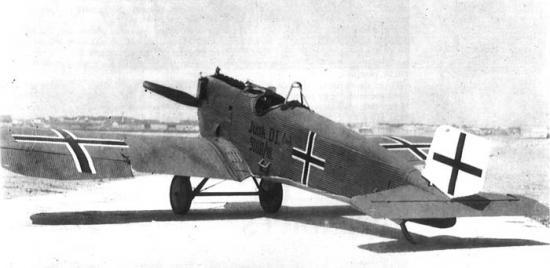
Junkers D I (J9) - Photo : source inconnue - Source unknown
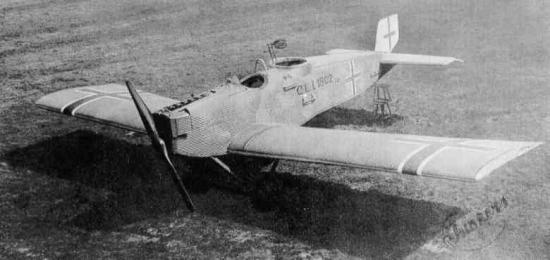
Junkers CL I (J10) - Photo : source inconnue - Source unknown
Le 21 janvier 1920, le lieutenant Osterkamp est démobilisé et passe quelques temps à l’hôpital, épuisé par sa campagne balte. Il en sortira pour devenir directeur des ventes de la Gustav Freund Automobil. Fin 1926, il prend la direction de la station d’hydravions Severa GmbH (compagnie para-militaire opérant pour la Reichsmarine). Puis au début des années trente, il dirige la Seeflugstation de Norderney (île du Nord de l’Allemagne).
On January 21st, 1920, the Lieutenant Osterkamp is demobilized and spends time at the hospital, exhausted by his Baltic campaign. He then went out to become sales director of Gustav Freund Automobil. In late 1926, he took the management of the Severa GmbH seaplanes station (paramilitary company operating for Reichsmarine). Then, in the early thirties, he managed the Seeflugstation of Norderney (island in Northern Germany).
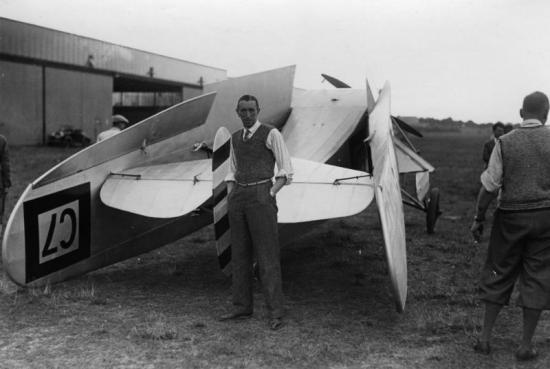
Theo Osterkamp, Berlin, 1931 © Bundesarchiv Bild 183-2008-1016-506
(Cette image est soumise aux droits de Creative Commons Attribution ShareAlike 3.0 Germany License)
(This picture is licensed under Creative Commons Attribution ShareAlike 3.0 Germany License)
Il ira clandestinement au centre d’entraînement de la Reichswehr de Lipetsk (URSS). En 1934, après la prise de pouvoir d’Hitler, et la nomination comme Ministre de l’Air de Göring, Osterkamp ne résiste pas à l’envie de reprendre du service, bien que voyant d’un mauvais œil le nazisme. Il sera officiellement Lieutenant au Ministère de la Défense.
He then went in secret in the training center of the Reichswehr at Lipetsk (USSR). In 1934, after Hitler was appointed Chancellor and Göring Air Minister, Osterkamp did not resist to enlist again, although looking unfavourably on the Nazism. He became officially Lieutenant in the Ministry of Defence.
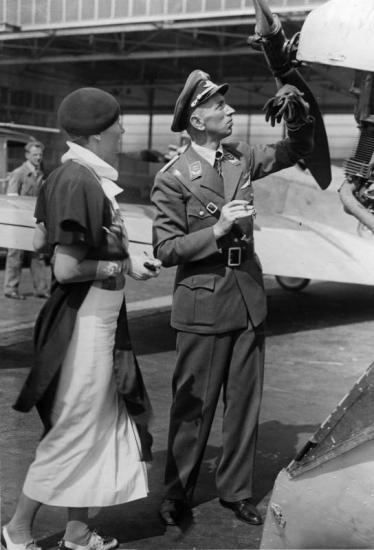
Theo Osterkamp Avec sa fiancée en 1933 - With his girl friend in 1933
© Bundesarchiv Bild 183-2008-1016-504
(Cette image est soumise aux droits de Creative Commons Attribution ShareAlike 3.0 Germany License)
(This picture is licensed under Creative Commons Attribution ShareAlike 3.0 Germany License)
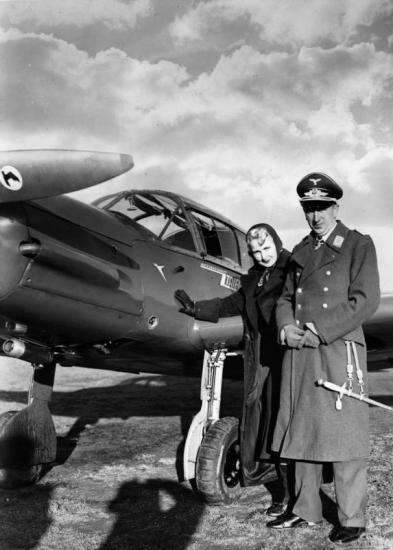
Theo Osterkamp
Devant un Bf 108 avec sa femme Gattin - In front of a Bf 108 with his wife Gattin
© Bundesarchiv Bild 183-H16409
(Cette image est soumise aux droits de Creative Commons Attribution ShareAlike 3.0 Germany License)
(This picture is licensed under Creative Commons Attribution ShareAlike 3.0 Germany License)
Promu Commandant, il prend la tête 4e escadrille de JG Richtofen, équipée de Heinkel 51A, le 1er avril 1935. Quelques semaines plus tard, il sera à la tête du groupe d’aviateurs sélectionnés pour le « Tour d’Europe », une compétition internationale partant de Varsovie et passant en Afrique du Nord.
Promoted Commander, he took the head of the 4th squadron of JG Richtofen, equipped with Heinkel 51A on April 1st, 1935. Some weeks later, he leaded the group of airmen selected for the " Tour of Europe ", an international competition starting at Warsaw and passing through North Africa.
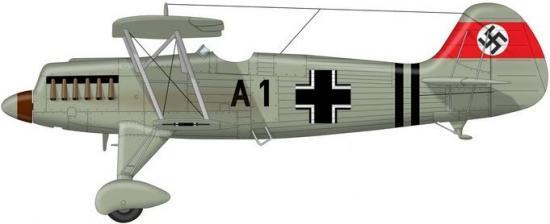
Heinkel He 51A-1 - Stab I/JG 132 "Richthofen" - Berlin-Doberitz.
Mars 1936 - March, 1936.
© Gaëtan Marie -Gaëtan Marie's Aviation Profiles http://www.gaetanmarie.com
Le 31 mars 1936, il est nommé Commandant de la II./JG 134 basée à Werl et équipée d’Arado 68.
On March 31st, 1936, he is named Commander of the II./JG 134 based at Werl and equipped with Arado 68.
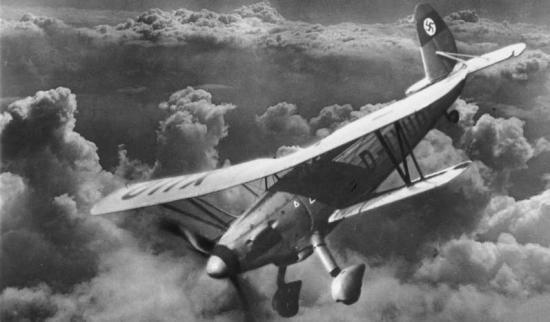
Arado Ar 68 © Klinke & Co Bundesarchiv Bild 146-1990-021-20
(Cette image est soumise aux droits de Creative Commons Attribution ShareAlike 3.0 Germany License)
(This picture is licensed under Creative Commons Attribution ShareAlike 3.0 Germany License)
Les premiers Messerschmitt Bf 109 B arriveront l’année suivante. Osterkamp les trouvaient rapides en montée et en vol horizontal.
The first Messerschmitt Bf 109 B arrived the following year.

Messerschmitt Bf 109 B, Stab II/JG 132 "Richthofen", 1938
Photo : auteur inconnu - author unknown
En novembre 1937, il devient directeur de l’école de chasse de Berlin Werneuchen jusqu’au 25 novembre 1939.
Osterkamp found it fast in climbing and horizontal flight. In November, 1937, he became director of the fighting school in Berlin Werneuchen until November 25th, 1939.
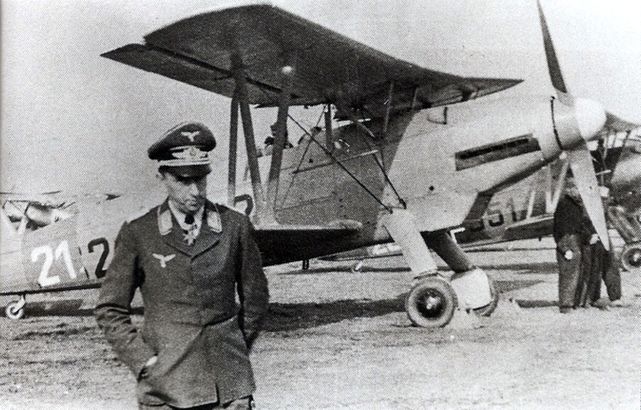
Theo Osterkamp & Arado Ar 68E-1 n°21, JFVS 1, Werneuchen
Photo : auteur inconnu - author unknown
La deuxième guerre mondiale - WWII

Messerschmitt Bf 109E-4 - I./JG 51
Nord de la France, début 1940 - Northern France, early 1940.
artiste inconnu - artist unknown - source : http://wp.scn.ru
Il deviendra ensuite Commandant de la JG 51 (25 novembre 1939 - 23 juillet 1940) à Münster Handorf . Pendant la « Sitzkrieg » (guerre de positions), la JG 51 ne remportera qu’une dizaine de victoires. Un jeune pilote abattra même un Fw 58 à bord duquel se trouvait le général Kurt von Döring. Le 10 mai 1940, Osterkamp mène lui-même ses 4 Gruppe au combat pour neutraliser au sol l’aviation néerlandaise. Mais ils ne trouveront pas d’objectifs valables. Le 12 mai, il revendique sa première victoire de la deuxième guerre mondiale sur un Fokker G1 au dessous de la route Arnheim-Amsterdam. Le 22 mai, il abat un Hurricane au dessus de Roubaix mais cette victoire ne sera pas revendiquée, faute de témoins ainsi que pour les trois autres avions abattus fin mai-début juin au dessus de Dunkerque (un Hurricane, un Blenheim et un Spitfire). Il recevra l’EK I à sa croix pour le mérite.
He then became Commander of the JG 51 (25 Novembre 1939 - 23 July 1940) at Münster Handorf. During the « Sitzkrieg » (war of position), the JG 51 claimed only around ten victories. A young pilot even shot down a Fw 58 with general Kurt von Döring on board. On May 10th, 1940, Osterkamp leaded himself his 4 Gruppe in a fight to neutralize on the ground the Dutch aviation. But they did not find valid objectives. On May 12th, he claims his first victory of the second world war on Fokker G1 below the road Arnheim-Amsterdam. On May 22nd, he shot down a Hurricane over Roubaix but this victory was not homologated by a lack of witness as for three other planes shot down in late May - early June over Dunkirk (a Hurricane, a Blenheim and a Spitfire). He received the EK I to his war merit cross.
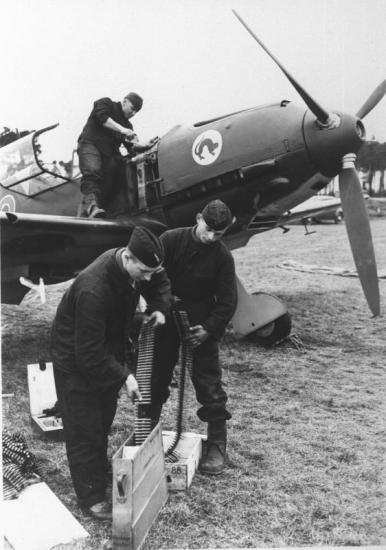
Messerschmitt Me 109 E-1 8./JG 51 (ex 2./JG 20) © Bundesarchiv Bild 146-1997-026-32A
(Cette image est soumise aux droits de Creative Commons Attribution ShareAlike 3.0 Germany License)
(This picture is licensed under Creative Commons Attribution ShareAlike 3.0 Germany License)
Pendant la bataille d’Angleterre, il connaît son premier combat important le 10 juillet 1940 au dessus de « Hellfire Corner » (Douvres) : la JG 51 a décollé de St Omer pour escorter les Dornier Do 17 de la 3e escadrille de la KG 2. 30 Me Bf 110 de la ZG 26 les escortent également. 6 Hurricane du n° 32 Sqn de Biggin Hill vont à la rencontre de ses 70 avions au dessus de la Manche. Puis des avions des Sqn 56, 64, 74 et 111 les rejoignent. De nombreux combats eurent lieu dans une grande mêlée d’avions. Trois chasseurs allemands furent perdus, un autre se posa sur le ventre à Wissant et un cinquième fut recueilli en mer par un hydravion. Le 13 juillet 1940, Osterkamp obtint sa dernière victoire : un Spitfire (ou un Hurricane) au dessus de Douvres en escortant des Stuka. Il avait 48 ans ! Il ramena difficilement son avion au Touquet, touché aux hélices.
During the battle of Britain, he had his first important fight on July 10th, 1940 above " Hellfire Corner " (Dover) : the JG 51 took off from St Omer to escort Dorniers Do 17 of the 3rd squadron of KG 2. 30 Me Bf 110s of the ZG 26 also escorted them. 6 Hurricanes of n° 32 Sqn of Biggin Hill came and faced these 70 aircrafts above the Channel. Then aircrafts of Sqn 56, 64, 74 and 111 joined them. Many different fights took place in a big mix of aircrafts. Three German fighters were lost, another one landed wheels retracted at Wissant and a fifth one was rescued offshore by a seaplane. On July 13th, 1940, Osterkamp obtained his last victory : a Spitfire (or a Hurricane) above Dover when escorting Stukas. He was 48 years old ! He flew back with difficulty his plane to Le Touquet, being touched to the propoeller.
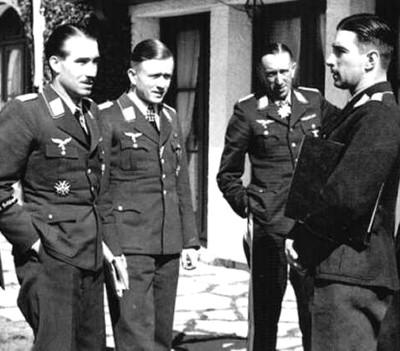
Galland, X, Osterkamp & Mölders - Photo : source inconnue - Source unknown
Une semaine plus tard, Werner Mölders remplace Osterkamp dans le cadre de la politique de rajeunissement opérée par Göring. Du 28 juillet au 7 août, Osterkamp assurera néanmoins l’intérim de Mölders, ce dernier étant blessé à la jambe. Puis il sera commandant de la chasse (Jagdfliegerführer) de la Luftflotte 2. Il sera ensuite Fliegerführer Afrika du 18 juillet 1941 au 31 mars 1942. Le 5 avril 1943, il devient commandant de la chasse en Sicile.
One week later, Werner Mölders replaced Osterkamp according to the politics of modernization perated by Göring. From July 28th till August 7th, Osterkamp nevertheless took Mölders' place, this one being injured at the leg. Then he became commander of the Luftflotte 2 fighters (Jagdfliegerführer). He was then Fliegerführer Afrika from July 18th, 1941 till March 31st, 1942. On April 5th, 1943, he became commander of the fighters in Sicily.
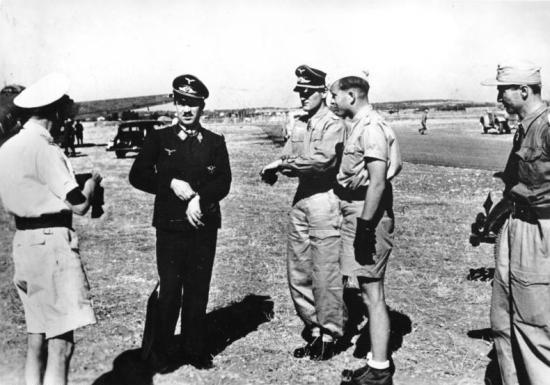
Osterkamp & Galland - Italie, 3 juillet 1943 - Italy, 3rd July, 1943.
© Ketelhohn - Bundesarchiv Bild 183-J14659
(Cette image est soumise aux droits de Creative Commons Attribution ShareAlike 3.0 Germany License)
(This picture is licensed under Creative Commons Attribution ShareAlike 3.0 Germany License)
Le 28 juillet 1944, il est mis sur la « touche » en étant muté au Commandement de la Flieger Ersatz Division (Division de Relève de la Chasse). Mécontent, il critique la politique d’Hitler. Il sera relevé de son commandement le 31 décembre 1944, puis arrêté par la Gestapo et enfin chassé de la Wehrmacht. Il retournera dans son village natal et sera arrêté par les américains en mai 1945 – ses décorations lui seront volées – et interné en Angleterre jusqu’en 1946. Il travaillera dans le monde des affaires jusqu’en 1966. Il deviendra président de l’Association des vétérans de l’ordre « Pour le Mérite ». Il décède le 2 janvier 1975 à Baden-Baden.
On July 28th, 1944, he was "retired" by being moved to the Headquarter of the Flieger Ersatz Division (Division of Replacement Fighters). Dissatisfied, he criticized the Hitler's politics. He lost his commanding position on December 31st, 1944, then arrested by the Gestapo and finally excluded from the Wehrmacht. He returned in his home town and was arrested by the Americans in May, 1945 - his decorations were stolen - and interned in England until 1946. He worked in the business until 1966. He became president of the Veterans Association of the order "Pour le Mérite". He died on January 2nd, 1975 in Baden-Baden.
34 victoires aériennes - 34 aerial victories
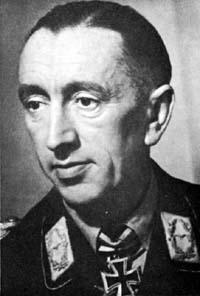
Osterkamp - Photo : source inconnue - Source unknown


